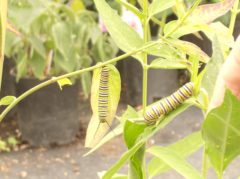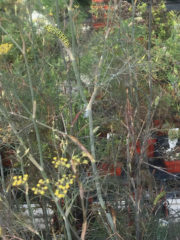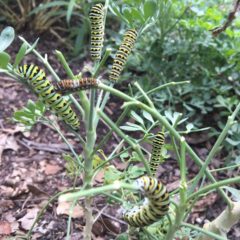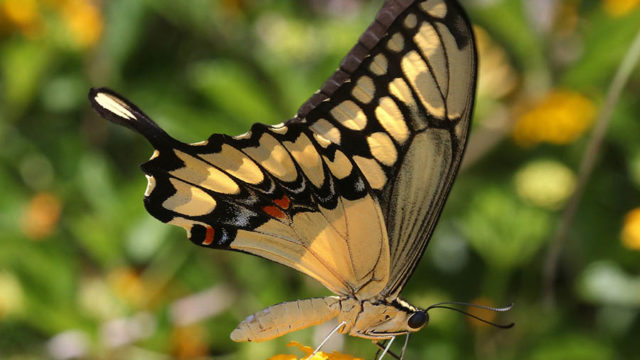 by Lenora Larson
by Lenora Larson
Butterfly gardening is easy and very rewarding because the Kansas City area is home to over 50 species of butterflies. Unfortunately, many gardeners only see the occasional migrating Monarch. Insecticides may be the problem. If you are a gardener who hates insects and must have perfect plants, then butterfly gardening is not for you.
Lack of sunlight may also be an obstacle. Butterflies are cold-blooded and must have the sun’s heat to fuel their short life of love. Nectar-rich flowers also need the sun to bloom. However, if you can forgo insecticides and have a large sunny garden, then you are well on your way to butterfly gardening success.
Integrate a Butterfly Garden Into Your Existing Space
You should not create a new garden because you probably already have everything adult butterflies need: nectar-rich flowers, blooming from March to October. The aptly named Butterfly Bush (Buddleia) is a favorite source of nectar for many pollinators. Other favorites include Milkweeds, Lantana, Mexican Sunflower (Tithonia). Catmint (Nepeta), Zinnia and Cosmos. Just be cautious about hybrids, which are bred for size and color and may be sterile. Many sterile flowers have no nectar and are as useless as a plastic flower to the butterflies.
The Secret to Success: Loving and Feeding Caterpillars
If all you offer are flowers, then you are merely a low-life nectar bar serving only adult beverages. And you have already maximized the effectiveness of flowers to attract butterflies. Planting more flowers will not bring more species and numbers of butterflies. No, the real key to butterfly gardening is feeding the caterpillars. Unlike adults that can sip nectar from many varieties of flowers, the caterpillar of each species of butterfly eats only a very specific plant leaf. For instance, the only food a Zebra Swallowtail caterpillar can eat is Paw-Paw leaves. No Paw-Paws, no Zebras. You choose which butterflies are in your garden by planting the specific caterpillar food. Female butterflies will find your garden to lay their eggs on their special plant and you will be providing a home to generations of that species of butterflies every year. Best of all, many caterpillar food plants are also beautiful. Here are some examples that will please both you and the butterflies.
 Milkweeds
Milkweeds
Enjoy Monarchs in your garden from May to October by planting members of the Milkweed family, which are the only food for Monarch caterpillars. Garden-worthy perennial Milkweeds include pink Swamp Milkweed (Asclepias incarnate), and the cream and purple flowered Spider Milkweed (Asclepias viridis). The Tropical Milkweed (Asclepias curassavica) is the caterpillar’s favorite food. It is an annual in Kansas, but worth re-planting every year for its spectacular flower. CLICK FOR MONARCH PLANTS
 Parsley and Fennel
Parsley and Fennel
Black Swallowtails are very common because their caterpillars eat members of the Carrot family such as Queen Anne’s Lace, Dill, Carrots, Fennel and Parsley. I grow enough Parsley to feed both of us and enjoy petting the huge “Parsley Worms”. We both appreciate my Fennel, a perennial herb that I grew for its beauty and taste long before I knew that it was also a caterpillar food plant. Note: Dill is so fast-growing and wispy that it can’t keep up with herds of hungry caterpillars.
Snapdragons
If you grow a member of the Figwort family, such as Snapdragons, Toadflax or Angelonia, you already have the food plant for caterpillars of the Buckeye Butterfly. Just don’t kill the herds of hungry caterpillars. The plants will quickly recover after being munched on for two weeks and you will be rewarded with the beautiful beige and orange butterflies. Butterflies: Flying Flowers in your Garden!
 Rue
Rue
The old-fashioned herb, Rue, is a caterpillar food plant for the GIANT Swallowtail. This black and yellow beauty is the largest butterfly in North America with a 6” wing span. Watch for the 3” caterpillars, called ‘“Orange Dogs”, which deter predators by looking like huge, fresh bird droppings. The Black Swallowtail caterpillar also eats Rue.
A Safer, More Beautiful World
By following a few simple guidelines, you too can make the world more beautiful by becoming a butterfly gardener. Just remember:
- No insecticides
- Full-sun
- Caterpillar Food Plants
- Nectar-rich flowers from March to October
You will be rewarded by the flying flowers who call your garden their home.
